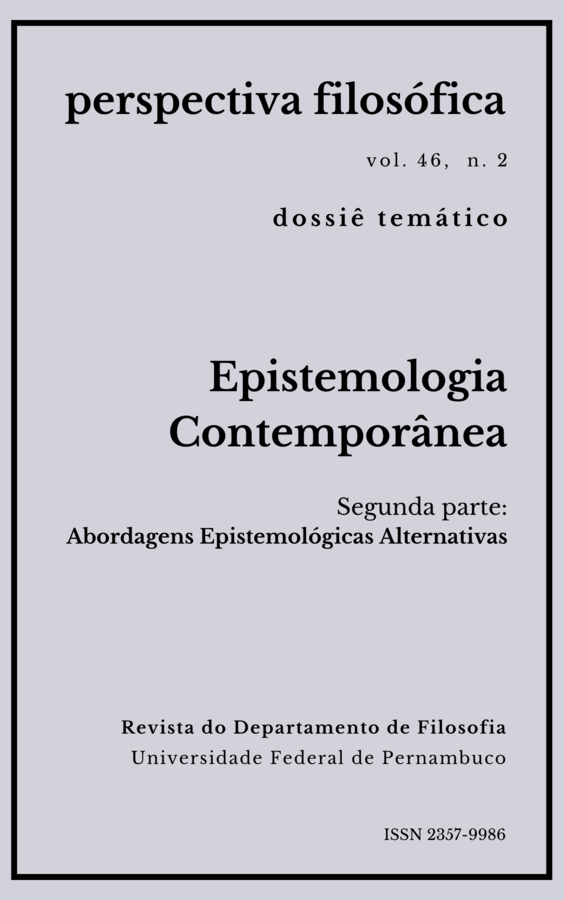Variedades do enativismo: propostas radicais e cognição superior
DOI:
https://doi.org/10.51359/2357-9986.2019.248072Keywords:
Philosophy of cognitive sciences, autopoietic enactivism, sensorimotor enactivism, Radical enactivism, higher cognitionAbstract
Since the 90th decade of the 20th century an interdisciplinary research pro-gram the trespass the areas of Philosophy, Cognitive Psychology, ArtificialIntelligence, Embodied Robotics and Linguistics has carving up space underthe name Enactivism. Show and contextualize the more radical enactive ap-proaches to high cognition is our goal in this paper. A significant motivationto have a positive attitude towards enactivism is its success in explanationsof vision that emphasize the active character of perception. For a certainenactivist reading visual perception is a kind of basic (non-representational)cognition that can be explained in a relational manner, through the skills ofthe cognitive agent engage in a determined environment and its characteris-tics. Follows that the perception is similar to, if not identified as, know-how.An overview of the varieties of enactivism is traced, with the goal of un-derstanding the anti-representational perspectives; with that is possible toapproach treatment, from a radical perspective, to the contexts that at firstglance demand the notion of representation in its explanation (contexts ofwhat could be call higher cognition). The varieties are the radical enactivism(REC), the autpoietic enactivism and the sensorimotor enactivism. After theexposition, we discuss some problems and possibilities of progress of the ra-dical explanation of higher cognition.References
GALLAGHER, S. “Understanding Others: Embodied Social Cognition”. In Handbook of Cognitive Science: An Embodied Approach Calvo, P. and Gomila, T. (eds.) (2008), pp. 439-52.
GALLAGHER, S., SOMOGY, V. “Social Constraints on the Direct Perception of Emotions and Intentions.” Topoi, no. 33: 195–99, 2014.
GIBSON, J. J. The Ecological Approach to Visual Perception. New York: Psychology Press. 2015.
DE JAEGHER, H. & DI PAOLO, E. “Participatory sense-making: An enactive approach to social cognition”. Phenomenology and the Cognitive Sciences 6(4), pp. 485–507, 2007.
DENNETT, D. Consciousness Explained. Boston: Little, Brown. 1991.
DI PAOLO, E., CUFFARI, E. C., & JAEGHER, H. D. Linguistic Bodies: the Continuity between Life and Language. Cambridge: MA: The MIT Press. 2018
HUFFERMANN, J. D. & NOGUEZ, P. M. R. “Propostas Enativas e a questão da continuidade entre formas de cognição”. Prometheus 33. Dossiê Linguagem e Cognição. 2020. E-ISSN: 2176-5960
HURLEY, S. “Perception and Action: Alternative Views.” Synthese 129, pp. 3–40, 2001.
HUTTO, D. “REC: Revolution Effect by Clarification”. Topoi 36(3), pp. 457–472, 2017.
HUTTO, D. D., MYIN, E. Evolving Enactivism: Basic Minds Meet Content. Cambridge, Massachusetts: The MIT Press. 2017.
HUTTO, D. D., MYIN, E. Radicalizing Enactivism: Basic Minds without Content. Cambridge, Massachusetts: MIT Press. 2013.
HUTTO, D. D., SATNE, G. “The Natural Origins of Content.” Philosophia 43 (3), pp. 521–36, 2015
HUTTO, D.D. 2005. “Knowing What?: Radical versus Conservative Enactivism”. Phenomenology and the Cognitive Sciences 4: 389–405.
KIVERSTEIN, J. & RIETVELD. E. “Reconceiving representation-hungry cognition: an ecological-enactive proposal”. Adaptive Behavior. Online first, 2018, p. 1-17.
MATURANA, H.R. & VARELA, F.J. Autopoiesis and cognition: the realization of the living. Kluwer, Dordrecht. 1980.
MERLEAU-PONTY, Maurice. Fenomenologia da Percepção. Trad. Carlos Alberto Ribeiro de Moura. São Paulo: M. Fontes. 1994.
MILLIKAN, R. White Queen Psychology and Other Essays for Alice. Cambridge: MIT Press, 1993.
MOYAL-SHARROCK, D. “From deed to word: gapless and kink-free enactivism”. Synthese. (2019) DOI: 10.1007/s11229-019-0218-5
NOË, A. Action in perception. MIT Press, Cambridge MA, 2004.
NOË, A. Varieties of presence. Harvard University Press, Cambridge, MA, 2012.
RAMSEY, W. “Must Cognition be Representational?”. Synthese, vol. 194, n. 11, p. 4197-4214, 2017 (2015).
ROLLA, G. “Enativismo Radical: Exposição, Desafios e Perspectivas” In Princípios: Revista de Filosofia. Natal, v. 25, n. 46, jan.-abr.2018
ROLLA, G. “Radically Enactive High Cognition” Disponível no academia.edu do autor Dissertatio, [s. l.], v. 47, p. 26–41, 2018.
O’REGAN, J. K. & NOË, A. 2001. “A Sensorimotor Account of Vision and Visual Consciousness”. Behavioural and Brain Sciences 24: 939–1031.
TURVEY, M. T., SHAW, R. E., REED, E. S., & MACE, W. M. “Ecological laws of perceiving and acting: In reply to Fodor & Pylyshyn”. Cognition, 9, 237–304. 1981.
VARELA, F.J, THOMPSON, E., ROSCH, E. The Embodied Mind. Cambridge, Massachusetts: MIT Press. 1991.
WARD, D. & SILVERMAN, D. & VILLALOBOS, M. “Introduction: The Varieties of Enactivism”. Topoi 36(3), 2017, pp. 365–375.
Downloads
Published
Issue
Section
License
A Revista Perspectiva Filosófica orienta seus procedimentos de gestão de artigos conforme as diretrizes básicas formuladas pelo Conselho Nacional de Desenvolvimento Científico e Tecnológico (CNPq). http://www.cnpq.br/web/guest/diretrizesAutores que publicam nesta revista concordam com os seguintes termos:
Os autores mantém os direitos autorais e concedem à revista o direito de primeira publicação, sendo o trabalho simultaneamente licenciado sob https://creativecommons.org/licenses/by/4.0/deed.pt_BR que permite o compartilhamento do trabalho com reconhecimento da autoria e publicação inicial nesta revista.
Os autores têm autorização para assumir contratos adicionais separadamente, para distribuição não-exclusiva da versão do trabalho publicada nesta revista, com reconhecimento de autoria e publicação inicial nesta revista (Consultar http://opcit.eprints.org/oacitation-biblio.html).

Esta revista está licenciada com uma Licença Creative Commons Atribuição 4.0 Internacional.













